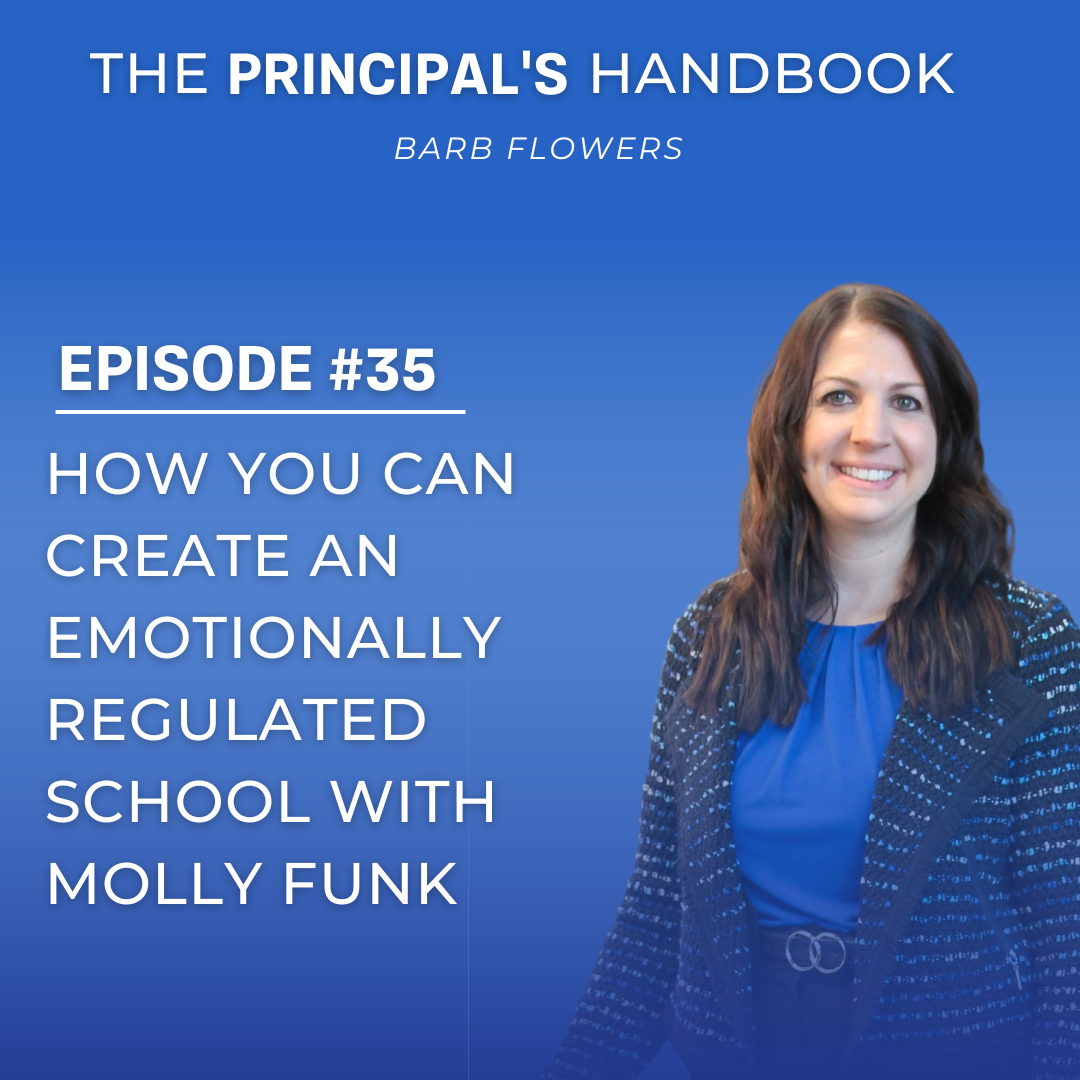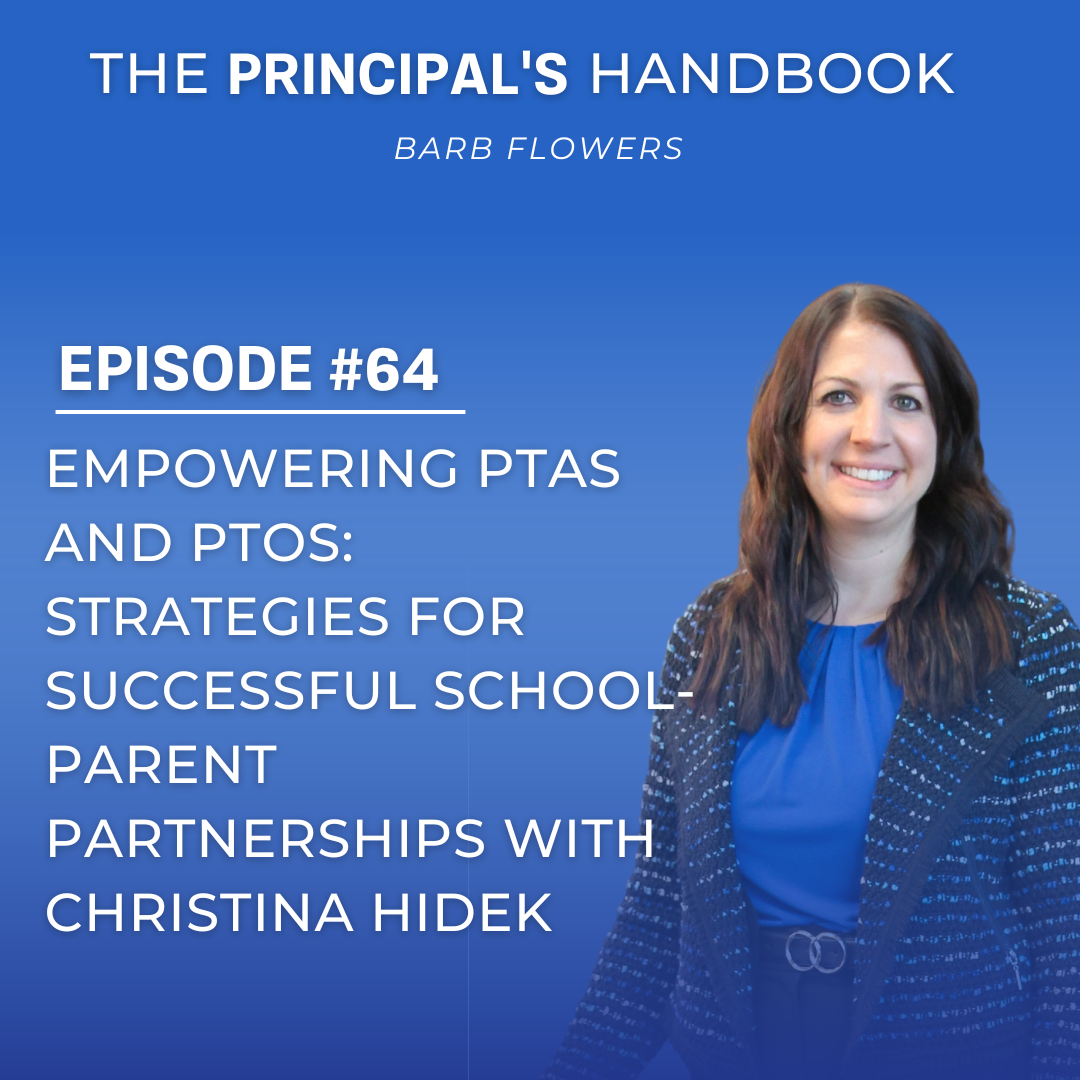[Intro – Barb Flowers]
Welcome to The Principal’s Handbook—your go-to resource for principals looking to revamp their leadership approach and prioritize self-care. I’m Barb Flowers, a certified life coach with eight years of experience as an elementary principal. Tune in each week as we explore strategies to boost mental resilience, manage time effectively, and nurture your overall wellness.
From managing daily challenges to building a healthier work-life balance, we’ll navigate the complexities of school leadership together. Welcome to a podcast where your well-being is the top priority.
[Main Conversation – Barb & Molly Funk]
Barb:
Welcome everyone to The Principal’s Handbook! I’m so excited to be here today with Molly Funk. We’re diving into what dysregulation looks like in schools and how we can create emotionally regulated environments. I’ve learned so much from Molly, and I know you’ll walk away with insights and strategies for your school.
Molly, let’s start with an introduction—tell us about your background and your journey in education.
Molly:
Thanks so much for having me, Barb. I’ve spent the last 12 years working with schools as a consultant and coach, focusing on teacher and leader effectiveness, professional learning rounds, and early literacy. Before that, I was a first-grade teacher, literacy coach, and Reading Recovery teacher. I also served as a principal for 10 years across five schools in two counties—most of it was turnaround work.
Eventually, I found myself drawn to supporting the adults who make the magic happen in the classroom, which led me to shift into professional learning and coaching.
Of course, everything changed after the pandemic. No matter what kind of school I was working with—urban, rural, elementary, or secondary—the conversation always came back to regulation: how we support the children and the adults doing this important work.
Barb:
Yes! I think this is such an important topic. We’re seeing so many stressors—burnout, behavior issues, teacher retention challenges, and lack of parental support. It’s a lot. And what you’re learning around regulation and mind-body wellness really brings hope. Can you talk more about how mind-body wellness connects with schools?
Molly:
Definitely. As I explored how to support schools more meaningfully, I realized how much I didn’t know—so I began studying mind-body medicine. I’m now in a PhD program focused on that, and I’m learning how to bridge that research with education and behavior change.
We’ve talked about the “whole child” in education for years, but we’ve never fully addressed the mind-body connection. We used to think our brains controlled everything, but research now shows it’s a two-way street—actually, 80% of the messages go from the body to the brain. That changes how we think about behaviors and emotions in schools.
Barb:
That’s so eye-opening. I’ve been learning from you how dysregulation impacts everyone—students, teachers, even parents. And as principals, if we don’t respond with calm, we unintentionally escalate things. So what exactly is dysregulation?
Molly:
Great question. Dysregulation is a nervous system state—our vagus nerve sends signals between our body and brain. When we’re dysregulated, we’re often in fight, flight, freeze, or fawn mode. You can see it: clenched fists, flushed faces, fast breathing, or withdrawn behavior. That’s the body responding to a perceived threat.
Whether it’s a student storming out of class, a teacher venting in your office, or a parent upset on the phone—those are nervous system responses. And the more we understand this, the better we can support others and ourselves.
Barb:
I love how you describe that. So many teachers are on edge, students are acting out, and it’s easy for emotions to spiral. As principals, we have to manage our own regulation while also supporting everyone else’s. It’s a lot.
Molly:
Exactly. And that’s why I say there are two parts to this: regulating yourself and co-regulating others. If a teacher walks into your office already escalated, and you’re not regulated yourself, it’s going to make things worse. We have to show up as that calming presence—a wet towel on a fire, not gasoline.
Barb:
I love that metaphor. And I’ve definitely seen how powerful it is when I stay calm and validate the teacher’s experience. It shifts the entire dynamic. So how do we actually do this in a school system where we only have one admin or one counselor and dozens of staff?
Molly:
This is where systems thinking comes in. We can’t rely on just a counselor or principal—we have to create emotionally regulated systems. That’s what makes it sustainable. Everyone in the building learns, practices, and models regulation. That’s how we build schools that support both wellness and learning.
Which leads to one of our favorite frameworks: The Three C’s of Co-Regulation. Want to dive into those?
Barb:
Yes! Let’s go for it.
The Three C’s of Co-Regulation
Molly:
The goal of co-regulation is to help someone get their thinking brain back online so they can function effectively again. It takes about 20 minutes for a person to fully regulate—but we can shorten that window when we’re intentional. That’s where the Three C’s come in:
1. Calm
-
What it is: Bringing a calm presence—physically and emotionally.
-
How to do it: Slow your breathing, soften your voice, relax your posture, and keep an open stance. Sit side-by-side or knee-to-knee—no desks between you.
-
Validate: Use the acronym VEST—Validate with Empathy and a Soft Tone. You don’t have to agree with their behavior, but you do have to honor their emotions.
Example: “You’re really overwhelmed right now. I can see that.”
2. Curious
Avoid using “why”—it implies blame and shuts people down. Stay focused on their experience, not your advice. No lecturing. No fixing.
Tip: Use their own words. “You said you were frustrated—tell me more about that.”
3. Creative
The goal is to empower them to make their own choices. Not “What do you want me to do?” but “What support do you need to move forward?”
Barb:
That is so powerful. The Three C’s are simple, but they take a real mindset shift. As principals, we often want to fix things. But giving people the space to problem-solve themselves is more powerful—and sustainable.
Molly:
Exactly. It creates a school culture of ownership, agency, and wellness. It’s not about one counselor or leader—it’s about everyone modeling these strategies. And when students start co-regulating each other? That’s when the system becomes truly self-sustaining.
Barb:
This has been such an inspiring conversation. Molly and I are so excited to be offering in-person and virtual trainings, as well as coaching to help schools build emotionally regulated systems. If you’re ready to move beyond Mindfulness Mondays and start creating real, lasting change, we’d love to partner with you.
You can download our free PDF in the show notes to get started—it includes more information on the Three C’s and three simple strategies you can use today to support regulation in students and staff.
Molly:
And if your school is interested in joining us for this journey—or even partnering for future research—we’d love to hear from you. We’re building something we believe is essential, and we’re excited to walk alongside others doing the same.
Barb:
Thank you, Molly, for sharing your insight and passion. And thank you to everyone who joined us today on The Principal’s Handbook. We’ll see you next time!






